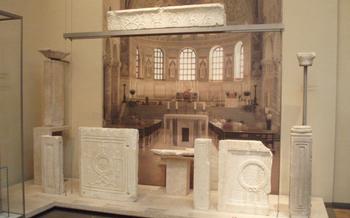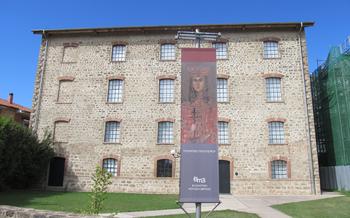
The Byzantine Fortress of Komotini
- Byzantine Fortress of Komotini: A Legacy of Defense and Heritage
- Architectural Features of the Fortress
- Exploration of the Fortress Grounds
- Visiting the Fortress Museum
- Events and Activities at the Fortress
- Tips for Planning Your Visit
- Tips for Photography Enthusiasts
- Tips for Families with Children
- Tips for Budget Travelers
- Tips for Physically Challenged Visitors
- Tips for Responsible Tourism
- The Legends and Myths of the Fortress
- The Cultural Significance of the Fortress
- Insider Tip:
Byzantine Fortress of Komotini: A Legacy of Defense and Heritage
The Byzantine Fortress of Komotini stands as a testament to the strategic significance of the region during the Byzantine Empire's reign. The empire's expansion eastward led to the establishment of Komotini as a key frontier outpost, safeguarding the empire's borders and controlling access to the Balkans. The fortress's construction in the 10th century marked the beginning of a new era for Komotini, transforming it into a fortified city that played a crucial role in defending the empire against invasions from the north.
The fortress's commanding position atop a hill overlooking the valley provided a strategic advantage, allowing its defenders to spot approaching enemies and repel attacks effectively. The Byzantines recognized the importance of securing this strategic location, and the fortress became a symbol of their military prowess and defensive capabilities. The fortress's enduring legacy as a symbol of resilience and defense continues to captivate visitors and history enthusiasts alike.
Architectural Features of the Fortress
The Byzantine Fortress of Komotini stands as a testament to the ingenuity and craftsmanship of the Byzantine Empire. Its imposing walls, reaching heights of up to 12 meters, are a sight to behold, showcasing the fortress's defensive capabilities. These walls are further reinforced by a series of towers, strategically positioned to provide a clear view of the surrounding landscape and allowing defenders to effectively repel any attackers.
The fortress's gateways and entrances are equally impressive, featuring intricate carvings and decorations that hint at the artistic prowess of the Byzantine builders. These entrances served as both defensive structures and ceremonial passages, welcoming visitors and dignitaries alike.
Within the fortress, visitors can explore the remains of a church and other structures that once served the needs of the garrison and the local community. These structures, though in ruins, offer a glimpse into the daily life and religious practices of the fortress's inhabitants.
The Byzantine Fortress of Komotini is a unique architectural marvel that blends Byzantine and local influences. Its impressive walls, towers, gateways, and internal structures stand as a testament to the engineering prowess and artistic sensibilities of the Byzantine Empire.
Exploration of the Fortress Grounds
The Byzantine Fortress of Komotini, a testament to the region's rich history, invites visitors to explore its captivating grounds. The main courtyard, the heart of the fortress, serves as a grand stage for events and gatherings, echoing with the footsteps of its illustrious past. Within the fortress walls, a labyrinth of chambers and rooms unfolds, each with its distinct story to tell. These spaces once served as living quarters, storage areas, and administrative offices, providing a glimpse into the daily lives of the fortress's inhabitants.
Adding to the intrigue, secret passages and tunnels crisscross the fortress, offering a sense of adventure and mystery. These hidden pathways, often concealed by time, lead to unexpected discoveries and provide a unique perspective on the fortress's intricate layout. Ascend to the top of the fortress, and you will be rewarded with panoramic vistas that stretch far and wide. The breathtaking views encompass the surrounding landscape, revealing the fortress's strategic significance and the panoramic beauty of the Komotini region.
Visiting the Fortress Museum
The Byzantine Fortress of Komotini houses a fascinating museum that delves into the rich history and heritage of the fortress and the surrounding region. Through a captivating collection of artifacts, interactive displays, and educational programs, the museum brings the fortress's story to life, offering visitors a deeper understanding of its significance and legacy.
The museum's exhibits showcase a diverse array of artifacts unearthed from the fortress grounds, ranging from ancient coins and pottery to armor and weaponry. These relics provide tangible evidence of the fortress's past, offering glimpses into the lives of its inhabitants and the events that unfolded within its walls.
Interactive displays bring the fortress's history to life, allowing visitors to engage with the material and immerse themselves in the narrative. Touchscreens, audio-visual presentations, and hands-on activities make learning about the fortress an interactive and engaging experience, particularly for younger visitors.
Educational programs and workshops are regularly offered at the museum, providing opportunities for visitors to delve deeper into specific aspects of the fortress's history and culture. These programs are led by knowledgeable historians and educators who share their insights and expertise with participants.
The museum also features a souvenir shop where visitors can purchase a variety of mementos and keepsakes to commemorate their visit. From books and postcards to replicas of artifacts and traditional crafts, the shop offers a range of items that celebrate the fortress's unique heritage.
Events and Activities at the Fortress
The Byzantine Fortress of Komotini is not just a historical monument; it is also a vibrant cultural hub that hosts a variety of events and activities throughout the year. These events are designed to showcase the fortress's rich heritage, engage visitors of all ages, and create a sense of community around this iconic landmark.
One of the most popular annual events is the Byzantine Festival, which takes place in the summer months. This festival celebrates the fortress's Byzantine roots and features traditional music, dance, food, and crafts. Visitors can immerse themselves in the culture of the Byzantine Empire and experience the fortress as it might have been centuries ago.
Historical reenactments and performances are another highlight of the fortress's events calendar. These events bring the fortress's history to life, allowing visitors to witness scenes from its past, such as battles, sieges, and royal processions. The reenactors wear authentic costumes and use replica weapons and armor, creating a truly immersive experience.
For those who prefer a more educational experience, guided tours of the fortress are available daily. These tours are led by knowledgeable guides who provide insights into the fortress's history, architecture, and significance. Visitors can learn about the different parts of the fortress, its construction techniques, and the role it played in defending the region.
Workshops and demonstrations are also offered at the fortress, allowing visitors to experience traditional crafts and skills firsthand. These workshops cover a variety of topics, such as pottery, weaving, metalworking, and cooking. Visitors can learn from local artisans and create their own unique souvenirs to take home.
Tips for Planning Your Visit
To fully appreciate the Byzantine Fortress of Komotini, it is crucial to plan your visit carefully. The best time to visit is during the shoulder seasons (spring and autumn) when the weather is pleasant, and the crowds are smaller. During the summer months, temperatures can soar, making it uncomfortable to explore the fortress's grounds.
Transportation to the fortress is readily available. Visitors can take a bus from Komotini's central bus station, which takes approximately 15 minutes. Alternatively, taxis are available for those who prefer a more direct route.
To grasp the fortress's history and significance fully, allocate at least two hours for your visit. This will allow you ample time to explore the grounds, visit the museum, and take in the panoramic views.
The fortress is equipped with various amenities and facilities to ensure a comfortable visit for all. Restrooms, a snack bar, and a souvenir shop are available within the fortress grounds. Additionally, there are designated areas for visitors to relax and enjoy the scenery.
Tips for Photography Enthusiasts
The Byzantine Fortress of Komotini offers a wealth of opportunities for photography enthusiasts to capture stunning images. The best time to visit the fortress for photography is during the golden hours of sunrise and sunset, when the warm light casts a magical glow on the ancient walls and towers.
When it comes to vantage points, there are several spots within the fortress that offer panoramic views. The top of the main tower provides a bird's-eye perspective of the fortress and the surrounding landscape. For unique and creative angles, explore the hidden corners and secret passages of the fortress, where you can capture intimate details and intriguing compositions.
Remember to be respectful of other visitors and follow the photography guidelines displayed within the fortress. The use of tripods and flash photography may be restricted in certain areas to preserve the integrity of the historical site.
Tips for Families with Children
Visiting the Byzantine Fortress of Komotini can be an exciting and educational experience for families with children. To make the most of your visit, here are a few tips to keep in mind:
-
Interactive Activities and Games: The fortress offers a variety of interactive activities and games that are designed to engage and entertain children. These activities include scavenger hunts, puzzles, and role-playing games that help bring the fortress's history to life.
-
Designated Play Areas: Within the fortress grounds, there are designated areas where children can safely play and run around. These areas are usually located away from the more fragile historical structures and provide a space for kids to let off some steam.
-
Educational Programs and Storytelling Sessions: The fortress museum offers educational programs and storytelling sessions that are tailored to young minds. These programs use interactive storytelling, hands-on activities, and multimedia presentations to teach children about the fortress's history and significance.
-
Family-Friendly Events and Workshops: Throughout the year, the fortress hosts family-friendly events and workshops that are designed to appeal to children of all ages. These events may include craft workshops, historical reenactments, and themed festivals that provide a fun and educational experience for the whole family.
Tips for Budget Travelers
Visiting the Byzantine Fortress of Komotini doesn't have to break the bank. Here are some tips for budget-conscious travelers:
-
Take advantage of discounts: Students and seniors are eligible for discounted admission fees. Make sure to carry your valid ID to avail these discounts.
-
Look for free guided tours: The fortress offers free guided tours on certain days of the week. Check the official website or inquire at the ticket counter for the schedule.
-
Explore budget-friendly accommodation options: There are several affordable guesthouses and hostels near the fortress. These offer basic but comfortable accommodation at a fraction of the cost of luxury hotels.
-
Dine like a local: Instead of splurging on expensive restaurant meals, try local eateries that offer delicious and budget-friendly Greek cuisine. Sample street food and visit the local market for fresh produce and snacks.
-
Save on transportation: If you're staying in Komotini, you can easily walk or cycle to the fortress. For those coming from further away, consider taking public transportation or renting a bicycle to save on transportation costs.
Tips for Physically Challenged Visitors
The Byzantine Fortress of Komotini welcomes visitors of all abilities and strives to ensure an accessible and enjoyable experience for everyone. Physically challenged visitors can take advantage of the following amenities and services:
-
Accessible Entrances and Ramps: The fortress features several accessible entrances equipped with ramps, allowing wheelchair users and visitors with limited mobility to enter and explore the grounds without difficulty.
-
Designated Parking Areas: Dedicated parking spaces for visitors with disabilities are available near the fortress, ensuring convenient access for those who drive.
-
Wheelchairs and Mobility Aids: Upon request, visitors can borrow wheelchairs or other mobility aids to assist with their exploration of the fortress. These aids are available at the fortress entrance or through the museum staff.
-
Assistance from Staff Members: The friendly and helpful staff at the fortress are always ready to provide assistance to visitors with physical challenges. They can offer directions, provide information, and assist with any special needs or requests.
Tips for Responsible Tourism
As visitors to the Byzantine Fortress of Komotini, it is imperative to embrace responsible tourism practices to preserve and protect its historical and cultural significance. Show respect for the fortress's architectural features and refrain from touching or damaging any structures. Adhere to proper etiquette by maintaining silence in designated areas and respecting the privacy of other visitors.
Minimize your environmental impact by disposing of waste responsibly and avoiding the use of single-use plastics. Support local businesses by purchasing souvenirs and dining at establishments in the vicinity of the fortress, contributing to the community's economic well-being. By embracing responsible tourism, you become an advocate for the fortress's preservation and ensure its legacy for future generations.
The Legends and Myths of the Fortress
The Byzantine Fortress of Komotini is steeped in a rich tapestry of legends and myths that have been passed down through generations. One of the most enduring tales is that of the hidden treasure buried beneath the fortress. According to legend, a wealthy Byzantine emperor hid a vast fortune in gold and jewels within the fortress walls to protect it from invaders. Over the centuries, many have searched for the hidden treasure, but none have ever succeeded.
Another popular legend tells of a secret tunnel that connects the fortress to the nearby village of Amaxades. It is said that the tunnel was used by the fortress's defenders to escape in times of danger. The entrance to the tunnel is said to be hidden within the fortress walls, but its exact location remains a mystery.
The fortress is also associated with several myths and beliefs. Some believe that the fortress is haunted by the ghosts of its former inhabitants. Others believe that the fortress has magical powers that can protect those who visit it. These legends and myths add to the mystique and allure of the Byzantine Fortress of Komotini, making it a truly captivating destination for visitors from all over the world.
The Cultural Significance of the Fortress
The Byzantine Fortress of Komotini stands as a testament to the rich history and cultural heritage of the region. Its strategic location and imposing architecture have shaped the identity and narrative of Komotini, making it an integral part of the city's cultural landscape. The fortress has played a pivotal role in attracting tourism to the region, drawing visitors who are eager to explore its fascinating past and witness its architectural splendor.
Efforts are continuously made to preserve and promote the cultural significance of the Byzantine Fortress of Komotini. Restoration projects and archaeological excavations have been undertaken to safeguard the fortress's structural integrity and uncover new insights into its history. Local authorities and cultural organizations collaborate to organize events, exhibitions, and educational programs that showcase the fortress's heritage and contribute to its ongoing legacy.
Research and documentation efforts are ongoing, with scholars and historians delving into the fortress's past to unravel its mysteries and shed light on its significance. Through meticulous research, new discoveries are made, enriching our understanding of the fortress's role in regional and Byzantine history.
The Byzantine Fortress of Komotini is not merely a historical relic; it is a living symbol of the city's cultural identity. Its enduring presence serves as a reminder of the region's resilience, its architectural achievements, and its connection to a rich historical tapestry that continues to inspire and captivate visitors from around the world.
Insider Tip:
Beyond the fortress's walls and within the village of Komotini, there's a small, unassuming bakery known for its exceptional boukovo, a traditional sweet treat made with layers of filo pastry, honey, and nuts. Indulge in this local delicacy to truly savor the flavors of the region and experience the warmth of Greek hospitality.





